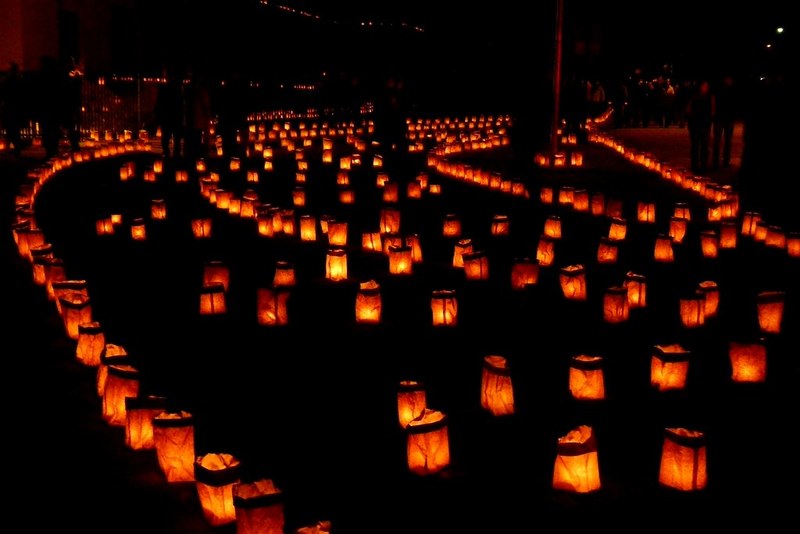
Lighting luminaries hearkens back to early Southwestern traditions during December.
In 1978, almost forty years after the Desert Botanical Garden (DBG) opened to the public, the Garden introduced its first Las Noches de las Luminaria. The celebration has evolved beyond candlelit desert paths; the annual event now includes bell choirs, bands, dancers, and light shows. In creating Las Noches de las Luminaria, the DBG drew upon a cultural form that had taken a new meaning in the American Southwest in the early twentieth century.
Lighting luminaries during the Christmas season originated in the American Southwest, specifically in northern New Mexico. It grew out of the efforts by Anglo leaders in Sante Fe to create a distinctive identity for the town and to promote that sensibility to Western travelers. Early twentieth-century Anglo leaders of Santa Fe had redefined the city's history by appropriating Native American and Mexican culture and traditions. Through its art, architecture, ceremonies, literature, and pageantry, the town established a mythic identity that has drawn tourists for more than one hundred years. These efforts included highlighting the city's architecture during the Christmas holiday season through the use of luminaries lining the parks, streets, walls, and flat rooftops of Santa Fe. Beginning in the 1920s and through the '60s, use of luminaries spread through the Southwest, including to Arizona. For example, in 1939, an article from the Arizona Daily Star encouraged Tucson residents to adopt the use of luminaries in their homes. It described how, in the previous year, the author saw the use of luminaries in Old Pueblo, Arizona and stated that the flat roofs of Southwestern style homes, such as in Santa Fe, Old Pueblo and Tucson, made excellent places for luminaries. Years later, for Christmas 1950, Tucson's Desert Garden Club members urged homeowners to use luminaries and "other beautiful decorations" to beautify the city for the holidays. Luminaries were again encouraged the following year as a way to capture the desert holiday spirit. In an article the next year, they added additional incentives, appealing to children with the argument that luminaries may help direct Santa Claus to their Tucson homes.
If the use of luminaries in the Southwest has become a winter holiday custom over the past one hundred years, the precise origins of the use of luminaria have been obscured by that twentieth-century mythmaking. Santa Fe historian Pedro Ribera Ortega promoted the luminaria tradition in Santa Fe by linking it to the hills of Spain and Italy. Around the city of Belén, Spain, shepherds lit small, contained fires at night to stay warm, and in time these became known as luminaries. According to Ortega, it was during Spain's conquest of the Americas that luminaries traveled across the Atlantic Ocean, where they became popular in Mexico during winter nights. As Christian missions spread around the Mexican territory, indigenous peoples who converted to Christianity displayed luminaries to help lead the infant Jesus Christ into their homes. Ortega reported that poems and regional songs even describe the tradition of luminaries in Christmas celebrations. One poem by Dorothy Linney reads, "The little fires that blaze on Christmas Eve; are lit by simple folks who believe; the Christ Child wanders softly through the night; and blesses all who set a guiding light." According to Ribera, the decline of the Spanish missions contributed to the decreasing use of luminaries. It was this tradition that Santa Fe appropriated when it began lighting the city in the early twentieth century.
In creating its own Las Noches de las Luminaria in 1978, the Desert Botanical Garden in Phoenix drew upon the southwestern cultural tradition that had emanated from Santa Fe to broaden its appeal and create a new relationship with the community. Indeed, community outreach became more central to the Garden in the 1970s, when Charles A. Huckins became director and reinvented the Gardens by making them more accessible, including creating trails and education programs. As a thank you to the Phoenix community and its volunteers, the Desert Botanical Garden hosted a one-night winter celebration, showcasing the luminaria festival for the first time.
That first Las Noches de las Luminaria displayed approximately three thousand luminaries lining the trails and buildings; it was free for all visitors and open from 7 to 9 pm. Webster Auditorium, decorated with "piñatas and desert holiday arrangements," also offered hot chocolate and cookies. The festival grew larger with each passing year. By its fortieth anniversary, Las Noches de las Luminaria displayed more than eight thousand hand-lit luminaries. The event now includes luminary donated by individuals, as well as volunteers recruited for lighting the thousands of luminaries each year. The Garden also hosts various concerts during the festivities, from Native American Flute players and Mariachi bands to brass bands and bell choirs. Instead of one evening, Las Noches de las Luminaria can be seen throughout December.
edited 12/18/2019: mt
Images


